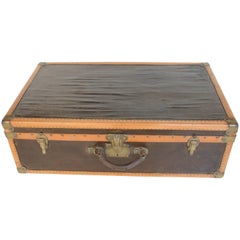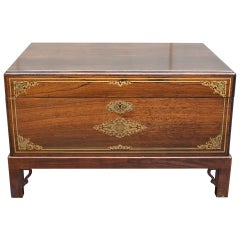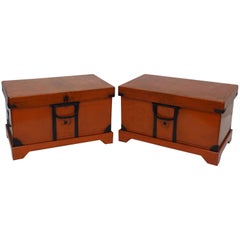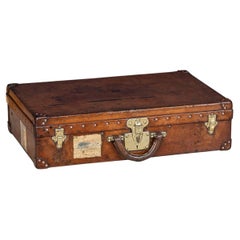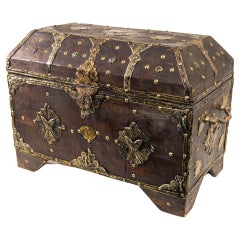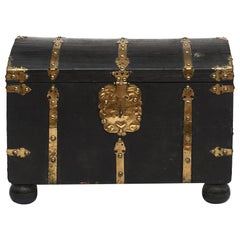Engraved Trunks and Luggage
to
2
1
1
2
1
1
1
2
2
1
1
1
2
2
2
2
2
1
Technique: Engraved
Louis Vuitton Early 20th Century Luggage Suitcase Brown Leather Brass Locks
Located in Sacile, PN
Suitcase by Louis Vuitton, dated 1910 circa. Engraved latch, brown and camel leather.
Category
Early 20th Century French Engraved Trunks and Luggage
Materials
Brass
Wedding Chest with Bronze Inlay on a Custom Stand-France, c. 1860
Located in West Palm Beach, FL
Antique rosewood French wedding chest made as a fancy and expensive gift for the bride. The rosewood chest has gilt bronze stringing and Boulle style inlay of mother-of-pearl and bro...
Category
19th Century French Napoleon III Antique Engraved Trunks and Luggage
Materials
Bronze
Related Items
Pair of Japanese Lacquered Trunks or Tables on Custom Stands, 19th Century
Located in San Francisco, CA
A pair of lacquered trunks with iron hardware mounted on custom-made later stands. One trunk having a single drawer at one end. The detachable lids on these trunks are linen wrapped ...
Category
Late 19th Century Japanese Edo Antique Engraved Trunks and Luggage
Materials
Iron
H 16 in W 27 in D 15.75 in
20th Century Louis Vuitton Cow Hide Suitcase, France c.1920
Located in Royal Tunbridge Wells, Kent
A highly unusual and exceptionally rare Louis Vuitton suitcase, originating from the early years of the 20th century, distinguishes itself not with the globally renowned monogram canvas but with a distinctive covering crafted from a singular piece of cowhide. This unique piece represents a special order from Louis Vuitton, showcasing the brand's historical commitment to utilizing only the finest hides available.
Unlike many of its counterparts, leather trunks and cases of this era often struggle to withstand the test of time, requiring regular treatments to prevent drying and disintegration. Remarkably, this particular example defies the odds, retaining the same supple quality it possessed on the day it first graced the shop floor. This suitcase belongs to Louis Vuitton's collection of "speciality materials," which encompasses a diverse range, including, but not limited to, zinc, copper, crocodile leather, and cow leather.
A brief history about Louis Vuitton trunks: Louis Vuitton was born in 1821 to a farmer and milliner and came from a long-established working-class family in eastern France. Vuitton grew up understanding the effects of perseverance and a strong work ethic from watching his family. At the age of 16, he made the decision to walk 292 miles from his hometown to Paris to try and make a new life for himself. When he arrived the city was in the midst of industrialization with current modes of transportation evolving quickly allowing for longer journeys. With this came the need for sturdy travel pieces.
Vuitton was taken as an apprentice for a successful box maker and packer named Monsieur Marechal. He learned to craft durable containers and how to pack them properly – a well-respected profession at the time.In 1854, years after he had mastered his craft and became well respected for it, Vuitton ventured out on his own to open a shop on Rue Neuve des Capucines. It was here that he began to establish himself as a luggage maker. Then, in 1858, Vuitton designed the first Louis Vuitton steamer trunk. At the time trunks had rounded tops to allow for water to run off but this did not allow for convenient stowage. Vuitton introduced a flat, yet waterproof, trunk that was easily stackable. The first of his trunks were outfitted with a grey canvas referred to as Trianon – it wouldn’t be until several decades later that the signature monogram would be introduced.
With a burgeoning business, Vuitton moved his family and workplace to Asniere, where he employed twenty workers to craft his trunks. By 1900 he would have 100 employees, and in 1914 the company would more than double in size. After years of success, Vuitton began to experiment with the design of his luggage by introducing a new striped canvas pattern (1876) and later the still well-known Damier print (1888). The hand-painted patterns were developed to prevent counterfeits. Even in the late 1800s, Louis Vuitton was enough of a status symbol to warrant counterfeiting. In 1886, his son George invented and patented an ingenious locking system that made it impossible to pick the lock of their trunks. This lock is still used today.
1892 would prove to be a time of mourning for the family as Louis Vuitton passed...
Category
20th Century French Other Engraved Trunks and Luggage
Materials
Brass
Japanese Vintage Wedding Chest with Brown Lacquer and Hand-Painted Décor
Located in Yonkers, NY
A vintage Japanese reddish brown lacquered wedding chest from the mid 20th century, with hand-painted foliage and floral décor and ropes. Created in Japan during the midcentury period, this vintage wedding box features a reddish brown lacquer perfectly accented by a gilded hand-painted décor depicting bamboo sticks with their leaves and delicate flowers. Created to be part of the extensive wedding trousseau provided to the daughter, this chest showcases a linear silhouette perfectly complimented by a dark reddish brown lacquer. A rectangular lid is adorned with ornate brass corners. The top and the façade are adorned in continuity with a gilded hand-painted décor showcasing bamboo sticks and their leaves, as well as delicate flowers. The sides are adorned as well, the back is more sparse with simple leaves. Wrapped with ropes, this vintage Japanese wedding chest...
Category
Mid-20th Century Japanese Engraved Trunks and Luggage
Materials
Wood
20th Century Louis Vuitton Suitcase In Natural Cow Hide, France c.1910
Located in Royal Tunbridge Wells, Kent
A highly unusual and exceptionally rare Louis Vuitton suitcase, originating from the early years of the 20th century, distinguishes itself not with the globally renowned monogram canvas but with a distinctive covering crafted from a singular piece of cowhide. This unique piece represents a special order from Louis Vuitton, showcasing the brand's historical commitment to utilising only the finest hides available.
Unlike many of its counterparts, leather trunks and cases of this era often struggle to withstand the test of time, requiring regular treatments to prevent drying and disintegration. Remarkably, this particular example defies the odds, retaining the same supple quality it possessed on the day it first graced the shop floor. This suitcase belongs to Louis Vuitton's collection of "speciality materials," which encompasses a diverse range, including, but not limited to, zinc, copper, crocodile leather, and cow leather.
A brief history about Louis Vuitton trunks: Louis Vuitton was born in 1821 to a farmer and milliner and came from a long-established working-class family in eastern France. Vuitton grew up understanding the effects of perseverance and a strong work ethic from watching his family. At the age of 16, he made the decision to walk 292 miles from his hometown to Paris to try and make a new life for himself. When he arrived the city was in the midst of industrialization with current modes of transportation evolving quickly allowing for longer journeys. With this came the need for sturdy travel pieces.
Vuitton was taken as an apprentice for a successful box maker and packer named Monsieur Marechal. He learned to craft durable containers and how to pack them properly – a well-respected profession at the time.In 1854, years after he had mastered his craft and became well respected for it, Vuitton ventured out on his own to open a shop on Rue Neuve des Capucines. It was here that he began to establish himself as a luggage maker. Then, in 1858, Vuitton designed the first Louis Vuitton steamer trunk. At the time trunks had rounded tops to allow for water to run off but this did not allow for convenient stowage. Vuitton introduced a flat, yet waterproof, trunk that was easily stackable. The first of his trunks were outfitted with a grey canvas referred to as Trianon – it wouldn’t be until several decades later that the signature monogram would be introduced.
With a burgeoning business, Vuitton moved his family and workplace to Asniere, where he employed twenty workers to craft his trunks. By 1900 he would have 100 employees, and in 1914 the company would more than double in size. After years of success, Vuitton began to experiment with the design of his luggage by introducing a new striped canvas pattern (1876) and later the still well-known Damier print (1888). The hand-painted patterns were developed to prevent counterfeits. Even in the late 1800s, Louis Vuitton was enough of a status symbol to warrant counterfeiting. In 1886, his son George invented and patented an ingenious locking system that made it impossible to pick the lock of their trunks. This lock is still used today.
1892 would prove to be a time of mourning for the family as Louis Vuitton passed...
Category
20th Century French Other Engraved Trunks and Luggage
Materials
Brass
H 6.7 in W 25.99 in D 16.93 in
Fireplace Bronze Andirons with Amphoraes
Located in Alessandria, Piemonte
Elegant pair of French andirons with bronze amphoraes.
To be used also as bookends.
ref. M/943.
Category
Mid-19th Century French Napoleon III Antique Engraved Trunks and Luggage
Materials
Bronze
Distressed Leather Suitcase with Brass Locks, circa 1940
Located in San Francisco, CA
About
A distressed leather suitcase with leather handle, fabric interior and brass locks. Key is missing.
Creator: Unknown.
Date of manufacture: circa 1940.
Materials and technique...
Category
Early 20th Century Industrial Engraved Trunks and Luggage
Materials
Brass
English 1920s Sarah Rackett Metal Trunk with Handles Mounted on New Custom Stand
Located in Atlanta, GA
An English metal trunk from the early 20th century, on custom stand. Created in England during the first quarter of the 20th century, this metal trunk is accented with brass hardware...
Category
Early 20th Century English Engraved Trunks and Luggage
Materials
Metal, Brass
H 18 in W 30.25 in D 17.25 in
20th Century Louis Vuitton Suitcase Alzer 80, 1970
Located in Epfach, DE
909481 Alzer 80 80 cm x 26 cm 52.5 cm with removable tray
Louis Vuitton suitcase, Alzer 80 with removable tray, in wonderful, well-kept condition with origin...
Category
20th Century French Engraved Trunks and Luggage
Materials
Leather
Large Vintage Louis Vuitton Double Strap Leather Suitcase
Located in Bradenton, FL
Large Vintage Louis Vuitton leather suitcase. This beautiful piece of luggage features a round top handle and buckle fastenings. Cream colored inside fabric is in good condition and ...
Category
20th Century French Modern Engraved Trunks and Luggage
Materials
Leather
Indian Vintage Wedding Chest with Brass Foliage Décor and Multiple Compartments
Located in Yonkers, NY
A Indian wedding chest from the mid 20th century, with brass accents, multiple jewelry compartments, floral décor and petite central mirror. Creat...
Category
Mid-20th Century Indian Engraved Trunks and Luggage
Materials
Brass
H 17 in W 29.25 in D 17 in
French Solid Oak & Inlay Coffer
Located in Baton Rouge, LA
A long and narrow French solid oak and inlay paneled coffer. The facade has geometric inlay designs of alternating ebonized wood and satinwood with hand forged nailheads. The top, ma...
Category
19th Century French Other Antique Engraved Trunks and Luggage
Materials
Steel
20th Century Louis Vuitton Suitcase Classic Monogram Canvas 60s
Located in Turin, Turin
Timeless suitcase by Louis Vuitton from the 60s with rounded edges and a double zipper. It is easy to carry with its comfortable rounded handles and bears a removable ID holder. It i...
Category
1960s French Modern Vintage Engraved Trunks and Luggage
Materials
Leather
Previously Available Items
Vintage Moroccan Moorish Leather Clad Large Dowry Trunk
Located in North Hollywood, CA
Vintage Moroccan dowry trunk with an angular dome top, the wood has been covered in leather on all sides.
Adorning the leather surface are intricate bra...
Category
Mid-20th Century Moroccan Moorish Engraved Trunks and Luggage
Materials
Leather, Wood
Baroque Embossed Black Leather Chest
Located in Kastrup, DK
Baroque chest wrapped in black embossed leather.
Fitted with original brass hardware, lock and key.
Denmark 1700-1730. From former Danish manor.
Untou...
Category
18th Century Danish Baroque Antique Engraved Trunks and Luggage
Materials
Brass
Antique & Perfectly Hand Carved Teakwood Chinese Blanket Chest w. Boat Sculpture
Located in Lisse, NL
Early 20th century, richly carved Chinese trunk with decorations on all sides.
If you are looking for a decorative and useful piece of furniture with a distinct Asian design then th...
Category
Early 20th Century Asian Chinese Export Engraved Trunks and Luggage
Materials
Brass
H 22.6 in W 40 in D 19.9 in
Large Persian Chiseled Bronze Box Islamic Art, 19th Century
Located in Beuzevillette, FR
Important Persian chest in chiseled bronze with a geometric protrudes. Each of these projections is grave with flower decorations and foliage. Each side ...
Category
Mid-19th Century Asian Islamic Antique Engraved Trunks and Luggage
Materials
Bronze
Antique and Complete, Hand Carved Teakwood Chinese Blanket Chest w. Fan Pattern
Located in Lisse, NL
Early 20th century, richly carved Chinese Trunk with decorations all around.
If you are looking for a decorative and useful piece of furniture with a distinct Asian design then this all handcrafted Chinese 'blanket chest' could be perfect. By the way, just because it is called a blanket chest that does not mean that it has to be used as such. Although it would also look great at the footend of a bed, filled with bed linnen or otherwise. The totally different than usual design with its large amount of typical Chinese elements is what immediately drew our attention. The hand carved Chinese fan in the front, the rounded section (also ornately carved) in the middle of the lid, the fighting tiger and dragon...
Category
Early 20th Century Asian Chinese Export Engraved Trunks and Luggage
Materials
Brass
H 21.8 in W 39.7 in D 19.9 in
Midcentury Modern Beige Ostrich Type Leather Mexican Suitcase, Mexico, 1950
Located in Madrid, ES
Traveling chest in wood covered with ostrich-type engraving.
Category
1950s Mexican Mid-Century Modern Vintage Engraved Trunks and Luggage
Materials
Leather
H 9.85 in W 29.53 in D 19.69 in
Louis Vuitton "Suitcase Bisten" Toile Monogram '907927' and Clefs 132516
Located in Valladolid, ES
Louis Vuitton Valise Bisten, toile monogram (907927) and keys (132516) DEL ( 811210002).
In a very good condition! Amazing, a touch of class anywh...
Category
1970s French Mid-Century Modern Vintage Engraved Trunks and Luggage
Materials
Leather, Fabric
H 18.51 in W 27.56 in D 6.7 in
Louis Vuitton 1945 Suitcase-Trunk Alzer '113023'
Located in Valladolid, ES
Louis Vuitton suitcase-Trunk Alzer (113023),"monogram au pouchoir" and "Chasis vintage",
circa 1945. Cou 81017001. In a very good condition, awesome trunk for everywhere and for alw...
Category
1940s French Mid-Century Modern Vintage Engraved Trunks and Luggage
Materials
Brass
1800s Amerika Thorvald Bredson Colonial Domed Blanket Chest Steamer Trunk
Located in Hyattsville, MD
Appears all original, Early 1800s. A dome top with original lock and skeleton key.
Measure: W 40.75 x D 21½ x H 20½ in.
Category
Early 1800s American Federal Antique Engraved Trunks and Luggage
Materials
Wood
H 20.5 in W 40.75 in D 21.5 in
